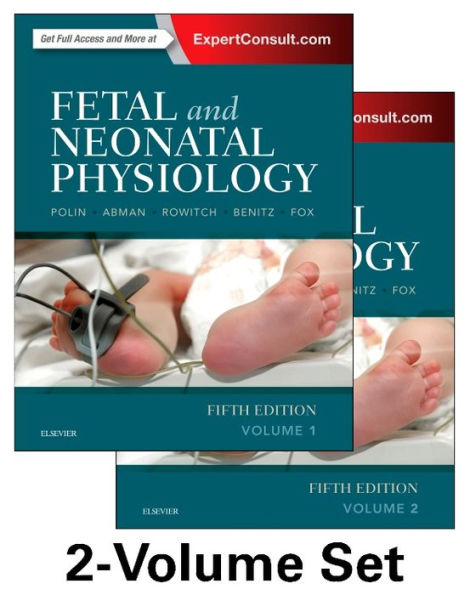Fetal & Neonatal Physiology provides neonatologist fellows and physicians with the essential information they need to effectively diagnose, treat, and manage sick and premature infants. Fully comprehensive, this 2-volume resource continues to serve as an excellent reference tool, focusing on the basic science needed for exam preparation and the key information required for full-time practice.
The 5th edition is the most substantially updated and revised edition ever. In the 5 years since the last edition published, there have been thousands of publications on various aspects of development of health and disease; Fetal and Neonatal Physiology synthesizes this knowledge into definitive guidance for today's busy practitioner.
- Offers definitive guidance on how to effectively manage the many health problems seen in newborn and premature infants.
- Chapters devoted to clinical correlation help explain the implications of fetal and neonatal physiology.
- Allows you to apply the latest insights on genetic therapy, intrauterine infections, brain protection and neuroimaging, and much more.
- Expert Consult eBook version included with purchase. This enhanced eBook experience allows you to search all of the text, figures, images, and references from the book on a variety of devices.
- Features a fantastic new 4-color design with 1,000 illustrations, 170+ chapters, and over 350 contributors.
- 16 new chapters cover such hot topics as Epigenetics; Placental Function in Intrauterine Growth Restriction; Regulation of Pulmonary Circulation; The Developing Microbiome of the Fetus and Newborn; Hereditary Contribution to Neonatal Hyperbilirubinemia; Mechanistic Aspects of Phototherapy for Neonatal Hyperbilirubinemia; Cerebellar Development; Pathophysiology of Neonatal Sepsis; Pathophysiology of Persistent Pulmonary Hypertension of the Newborn; Pathophysiology of Meconium Aspiration Syndrome; Pathophysiology of Ventilator Dependent Infants; Pathophysiology of Hypoxic-Ischemic Brain Injury; Pathophysiology of Neonatal White Matter Injury; Pathophysiology of Meningitis; Pathophysiology of Preeclampsia; and Pathophysiology of Chorioamnionitis.
- New Pathophysiology of Neonatal Diseases section highlights every process associated with a disease or injury, all in one place.
- In-depth information, combined with end-of-chapter summaries, enables deep or quick use of the text.
Fetal & Neonatal Physiology provides neonatologist fellows and physicians with the essential information they need to effectively diagnose, treat, and manage sick and premature infants. Fully comprehensive, this 2-volume resource continues to serve as an excellent reference tool, focusing on the basic science needed for exam preparation and the key information required for full-time practice.
The 5th edition is the most substantially updated and revised edition ever. In the 5 years since the last edition published, there have been thousands of publications on various aspects of development of health and disease; Fetal and Neonatal Physiology synthesizes this knowledge into definitive guidance for today's busy practitioner.
- Offers definitive guidance on how to effectively manage the many health problems seen in newborn and premature infants.
- Chapters devoted to clinical correlation help explain the implications of fetal and neonatal physiology.
- Allows you to apply the latest insights on genetic therapy, intrauterine infections, brain protection and neuroimaging, and much more.
- Expert Consult eBook version included with purchase. This enhanced eBook experience allows you to search all of the text, figures, images, and references from the book on a variety of devices.
- Features a fantastic new 4-color design with 1,000 illustrations, 170+ chapters, and over 350 contributors.
- 16 new chapters cover such hot topics as Epigenetics; Placental Function in Intrauterine Growth Restriction; Regulation of Pulmonary Circulation; The Developing Microbiome of the Fetus and Newborn; Hereditary Contribution to Neonatal Hyperbilirubinemia; Mechanistic Aspects of Phototherapy for Neonatal Hyperbilirubinemia; Cerebellar Development; Pathophysiology of Neonatal Sepsis; Pathophysiology of Persistent Pulmonary Hypertension of the Newborn; Pathophysiology of Meconium Aspiration Syndrome; Pathophysiology of Ventilator Dependent Infants; Pathophysiology of Hypoxic-Ischemic Brain Injury; Pathophysiology of Neonatal White Matter Injury; Pathophysiology of Meningitis; Pathophysiology of Preeclampsia; and Pathophysiology of Chorioamnionitis.
- New Pathophysiology of Neonatal Diseases section highlights every process associated with a disease or injury, all in one place.
- In-depth information, combined with end-of-chapter summaries, enables deep or quick use of the text.

Fetal and Neonatal Physiology, 2-Volume Set
1928
Fetal and Neonatal Physiology, 2-Volume Set
1928Hardcover(New Edition)

Product Details
| ISBN-13: | 9780323352147 |
|---|---|
| Publisher: | Elsevier Health Sciences |
| Publication date: | 07/01/2016 |
| Edition description: | New Edition |
| Pages: | 1928 |
| Product dimensions: | 9.60(w) x 11.70(h) x 4.30(d) |
